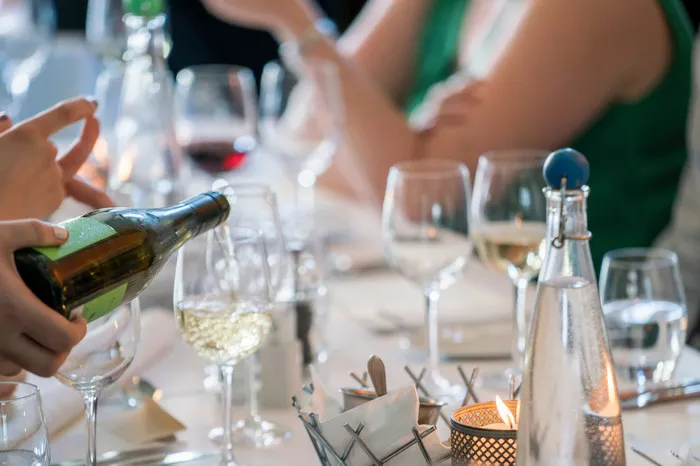When it comes to celebrating special occasions or enjoying a luxurious evening, champagne often takes center stage. The effervescent bubbles and delightful taste make it a favorite among many. But have you ever wondered about the caloric content of that celebratory bottle of champagne? In this article, we will delve into the world of champagne and explore the question: How many calories are there in a bottle of champagne?
1. Champagne and its Composition
Champagne, renowned for its elegance and sophistication, is a sparkling wine that originates from the Champagne region of France. It’s produced using a meticulous process known as the traditional method or méthode champenoise. A typical bottle of champagne is a blend of different grape varieties, such as Chardonnay, Pinot Noir, and Pinot Meunier. This amalgamation gives champagne its unique flavor profile.
Chardonnay: Known for its light and crisp character.
Pinot Noir: Adds body and complexity to the blend.
Pinot Meunier: Offers a fruity and approachable element.
2. Caloric Content of Champagne Varieties
Champagne comes in various styles, ranging from Brut to Demi-Sec, each with its own level of sweetness. The caloric content can vary based on the sweetness and alcohol content of the champagne. Here’s a breakdown of some common champagne varieties:
Brut Champagne:
Calories per standard 5 oz (150 ml) glass: Approximately 90-100 calories.
Calories per standard 750ml bottle: Around 600-650 calories.
Extra Brut Champagne:
Calories per 5 oz glass: Roughly 85-95 calories.
Calories per 750ml bottle: About 570-610 calories.
Sec and Demi-Sec Champagne:
Calories per 5 oz glass: Approximately 100-120 calories.
Calories per 750ml bottle: Around 660-800 calories.
3. Specific data on champagne calories:
According to calculations, a glass of red wine has about 130-170 calories, while a glass of champagne with a sugar content of less than 12 grams per liter has only 80-100 calories; , the heat of champagne is even more negligible.
According to a study on a glass of champagne with 12% alcohol content and 100 ml capacity, with four different sugar contents, the results show:
- Zéro dosage “zero added” champagne without any added sugar = 72 kcal;
- Brut natural champagne with 10 grams of sugar per liter = 76 kcal
- Sec Brut Champagne with 25 grams of sugar per liter = 82 kcal
- Doux sweet champagne with 50 grams of sugar per liter = 92 kcal.
4. Balancing Indulgence and Health
While it’s important to be mindful of the caloric content in champagne, it’s also crucial to strike a balance between enjoyment and health. Here are some tips:
Opt for Brut: If you’re watching your calorie intake, opt for Brut or Extra Brut champagnes, as they have lower sugar levels.
Moderation: Enjoy champagne in moderation. Savoring a glass or two can enhance your experience without overindulging.
Stay Hydrated: Drinking water alongside champagne can help mitigate the dehydrating effects of alcohol.
5. 5 Benefits of Champagne:
1. Lower blood pressure
A 2009 study published in the British Journal of Nutrition found that champagne has some nutritional benefits similar to red wine. Researchers conducted an experiment on a group of healthy individuals. One group drank champagne, and the other group drank a control drink with the same alcohol content as the champagne. Blood sample surveys showed that the blood of both groups was diluted and blood flow increased. However, only the champagne group had a slower elimination of nitric oxide from the blood, which means that champagne lowers blood pressure, which reduces the risk of stroke and heart disease.
2. Antioxidant
Champagne, like red wine, contains polyphenols with antioxidant functions, which can eliminate free radicals in the human body. Champagne is particularly rich in certain types of polyphenols that protect nerve cells from damage. If you add berries to champagne, such as strawberries, blueberries, raspberries or blackberries, you can achieve better health effects, and it can make champagne look more beautiful and drink more delicious. When drinking champagne, eating some orange, grapefruit or cranberry juice can also enhance its antioxidant function.
3. Strengthen brain function
Scientists at the University of Reading in the UK recently released a study that found that polyphenols in champagne can improve people’s spatial memory, thereby enhancing people’s ability to navigate, calculate and cope with complex tasks. In addition, Professor Jeremy Spencer, a professor of biochemistry, suggested that people over the age of 40 had better drink two to three glasses of champagne a week, which can prevent dementia and Alzheimer’s disease.
4. Improve mood
An Oxford University experiment found that 20 minutes after two groups of subjects drank champagne and another non-sparkling wine, the subjects who drank champagne had 20% higher blood alcohol levels than those who drank it. This is because the bubbles will enter the blood faster, causing the alcohol under the carbonization reaction to be “pushed” into the internal organs.
However, after 45 minutes, the alcohol levels of the two groups still tended to be the same. In other words, champagne can allow people to enter a state of excitement faster without consuming too much alcohol to damage the body. This is why champagne is often used to celebrate parties, as it can quickly improve our mood.
5. Improve the skin
Champagne’s antioxidants and tartaric acid can “detoxify” the skin and help even out skin tone. Especially for those with oily skin, champagne’s antibacterial properties can also prevent acne.
In conclusion, the caloric content of a bottle of champagne can vary depending on its sweetness, alcohol content, and serving size. While champagne adds a touch of luxury to special moments, it’s advisable to be mindful of its caloric impact.


